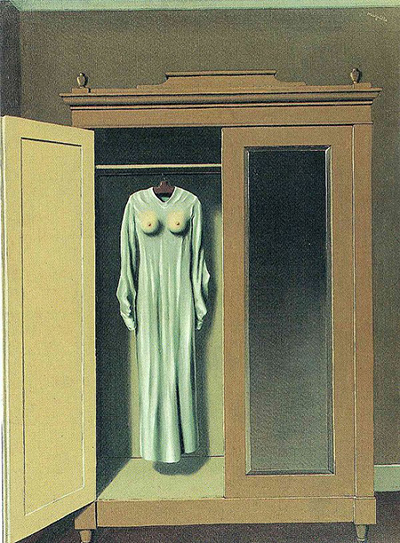Homage to Mack Sennett (En Homage a Mack Sennet) was painted in oil on canvas in 1934 and measures 73cm by 55cm. At the time the artist, in his mid-thirties, was living in Brussels.
This work depicts an ordinary, slightly dull, wooden wardrobe. An angle of wall and ceiling, a short section of skirting board and a dark brown floor hint at the ordinary room it is sitting in. One door of the wardrobe is open, revealing a long, narrow dress hanging alone from the rail inside.
A pair of naked female breasts are prominent on the front of the dress. This gives a surreal and uncomfortable air to an otherwise dreary scene that could be taken from any cheap hotel room of a certain era.
All the elements of the painting are rendered with realism and attention to detail. As with many of Magritte's works, it is their juxtaposition which creates the unreal feeling of the piece. The dress itself seems to have a life of its own, floating ghostlike above the floor of the wardrobe and hinting at a promise which is enhanced by the light falling on it, while the rest of the scene is in the shade.
It has been suggested that this soberly painted work references the artist's mother who committed suicide by drowning when he was thirteen years old. When she was discovered her dress was covering her face, leading to Magritte's fascination with faces being covered or missing. In this case the dress seems to symbolise a person, but the face is absent.
The title, Homage to Mack Sennett, references the Canadian-born actor, director and pioneer of slapstick comedy who founded Keystone Studios in California. Sennet's career was coming to an end at the time Magritte painted this piece. He directed his last films in 1935 before going into semi-retirement at the age of 55. He was known during his lifetime as the "King of Comedy" and earned academy awards in 1932 and 1938.




